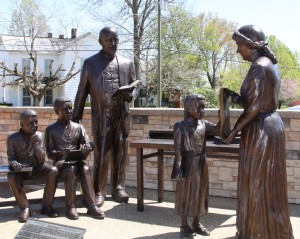“Public art is more than just display.” The words of Mayor Connelly during a student-conducted interview accurately sum up the message of the Berea Public Art Tour. Steven Connelly, mayor of Berea, recorded an oral history with Berea College students Terrin Vann, Molly Smith, and Nicole Reynolds, accompanied by Judy Sizemore, who works to promote the arts in schools in eastern Kentucky and is co-leading the Berea Public Art Tour project.

Left to right: Mayor Steven Connelly, Judy Sizemore, Terrin Vann, Molly Smith Photo taken by: Nicole Reynolds
As they inquired after many examples of public art found within Berea, of special interest was the mural in the Municipal Building, entitled “Berea Commencement in the Old Days.”In 1940, shortly after this building opened as the new post office, muralist Frank Long was commissioned to paint a scene on one of the interior walls. Long had a studio on Main Street, which served as his base as he painted murals both in and out of state. “Berea Commencement in the Old Days” is one of his last murals, and it adorns the building to this day. “People walk by them, but how often do they look up to see?” mused Connelly.
Even if people see and admire the local art, they may not be familiar with the stories involved with the work, such as that of Frank Long and the old post office mural. The Berea Public Art Tour seeks to promote these stories as integral to the appreciation of public art, identifying the artists involved, detailing how and where each piece or public event originated, and what it means to the community.

The project, funded by the NEA Fast Track grant, is a partnership among Berea College, lead artists/consultants Judy Sizemore and Joanna Hay, and sponsor Berea Tourism. Berea College students in Professor Libby Jones’ professional writing class and Professor Chris Green’s Appalachian history class are interviewing local artisans, under the guidance of Green, Jones, Sizemore, Hay, and the Kentucky Oral History Commission. The histories they record during these interviews will be archived in the Berea College Special Collections and Archives and compiled into a website, organized according the artistic/historical site they correspond to. It will feature twelve public art sites and two events. Each site or event will have its own page, which will feature photos, an oral and a written account, and a number to dial for a cell phone narration. A cell phone tour accessible outside of the website will also be developed.
Youth involvement in public art is key to the Berea Public Art Tour. Berea College students will not only collect oral histories and take photos, but they will also work with middle and high school students from Jackson, Clay, and Owsley Counties, actively engaging them with the public art sites. The middle and high school students will in turn give feedback on the experience, providing insight to local art’s impact on the youth of the region.[/vc_column_text][/vc_column][/vc_row]
 Rogers, and three students, produced by sculptor Stan Watts of Salt Lake City, Utah.
Rogers, and three students, produced by sculptor Stan Watts of Salt Lake City, Utah.
This park was a gift to the City of Berea from the College in celebration of Berea College’s 150-year anniversary in 2005. It stands near the site of Berea’s first school building, which was constructed in 1855. A later, brick building housed an elementary and high school on the very corner where the park stands now. Some of the bricks in the park’s walkway are from this building.
This site is yet another example of how public art and history are interwoven. The town itself is quite literally built and paved with the interaction between the two. Visitors and townspeople alike can get an idea of where Berea has been and where it is going to go. In public art we can see, according to Mayor Connelly, a “tangible exhibition of our humanity.”